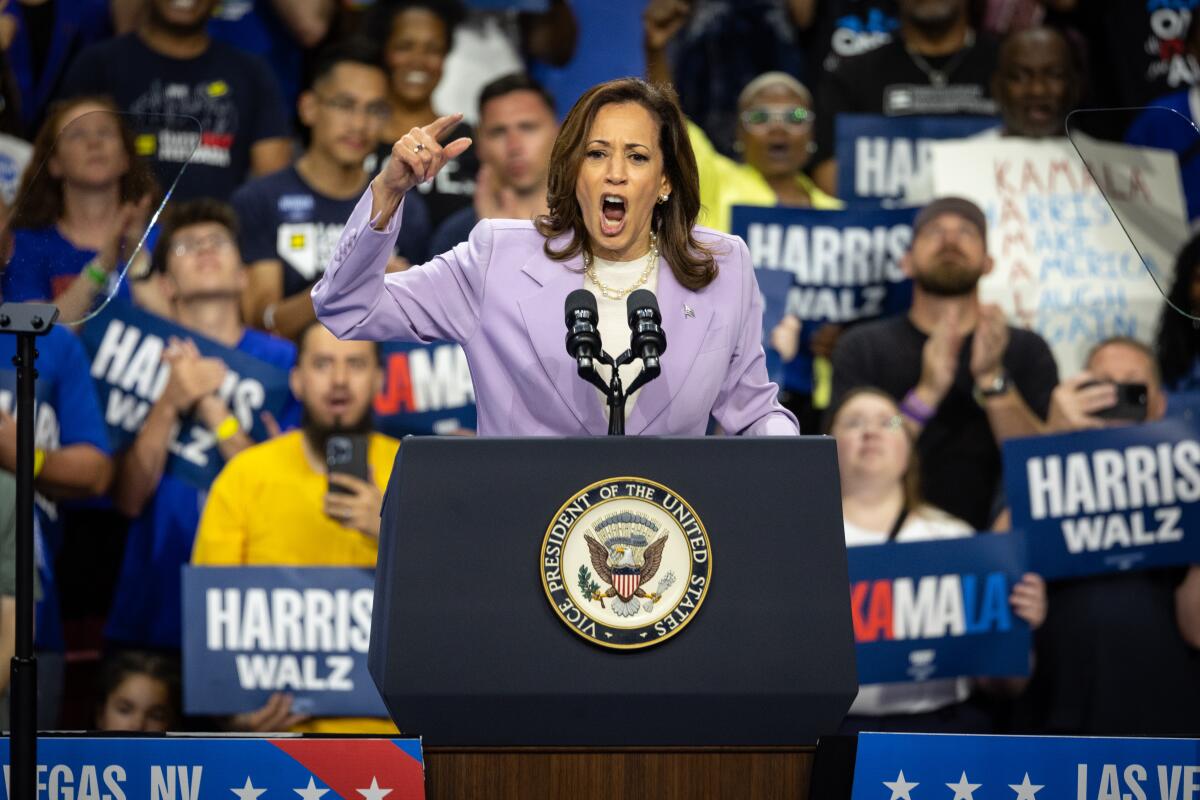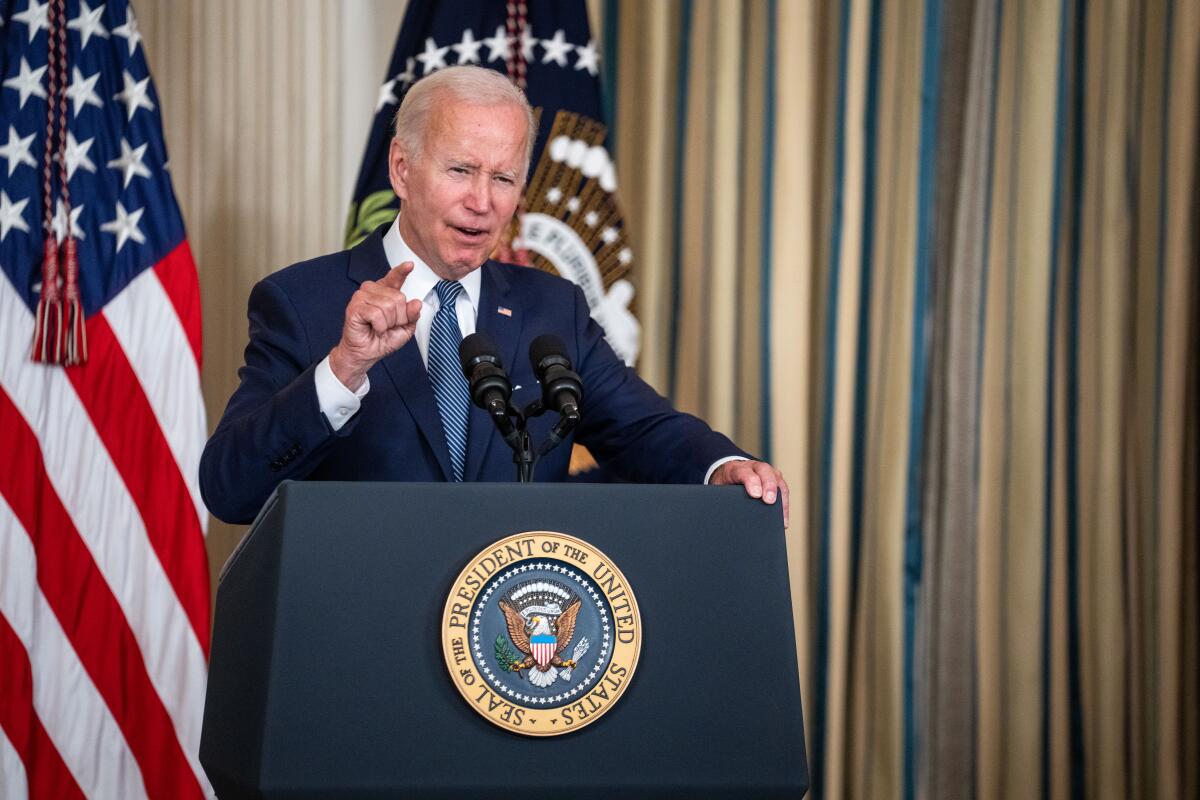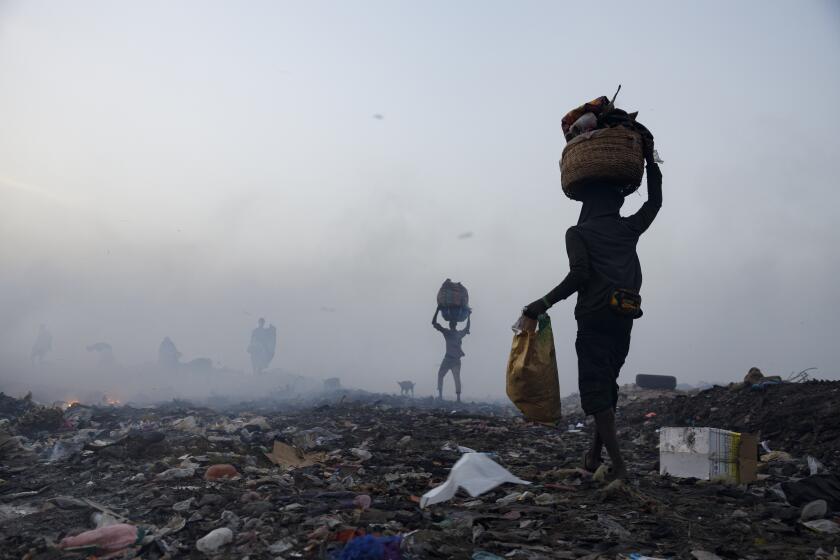Column: Young climate voters were tired of Biden. They’ve embraced Harris — mostly

Wei Zhou moved to the United States from Cambodia at age 13, leaving behind a Southeast Asian nation ravaged by worsening droughts and floods. By 14, Zhou had started volunteering for the Sunrise Movement, their climate activism informed by a keen sense that the world’s great injustices — among them global warming, poverty and genocide — were all connected.
Now 17 years old and living in Chicago, Zhou is a national organizer with Sunrise, talking with journalists on behalf of the youth-led organization and recently making a guest appearance on a podcast hosted by U.S. Sen. Edward Markey (D-Mass.). Zhou, who will turn 18 two weeks before the November election, is eager to see former President Trump, a climate denier, defeated.

But when I spoke with Zhou in July, they weren’t sure they could bring themselves to vote for Trump’s opponent.
“It’s hard for me as a climate organizer to be in good faith supporting Biden,” Zhou said.
Eleven days later, Biden announced he wouldn’t seek reelection. And everything changed.
You're reading Boiling Point
Sammy Roth gets you up to speed on climate change, energy and the environment. Sign up to get it in your inbox twice a week.
You may occasionally receive promotional content from the Los Angeles Times.
In the same way that Kamala Harris — who quickly secured Biden’s support, and eventually the Democratic Party’s nomination — has reenergized the Democratic base as a whole, she has ignited newfound enthusiasm among climate advocates young and old.
She pulled off the remarkable feat despite having served as Biden’s vice president, standing by as he approved the huge Willow oil project in Alaska and oversaw record oil and gas production. And she did it even as some youth activists — eyes wide open to the alarming science of the climate crisis — felt she had yet to articulate a bold enough plan for phasing out fossil fuels.
How did Harris engineer such a dramatic turnaround?
“I don’t think it’s about a big shift in messaging. I think it’s about the messenger,” Sierra Club Executive Director Ben Jealous said.
The Sierra Club was all in on Biden from the beginning. But many other environmental groups withheld their endorsements.
It hardly mattered that Biden had pushed a landmark $370-billion climate and clean energy bill called the Inflation Reduction Act through Congress. Or that he had protected more than 1.6 million acres of public lands as national monuments; established the American Climate Corps, a job-training program; and paused approval of gas export terminals. Many young climate activists felt a distinct lack of enthusiasm for an aging candidate whose focus seemed to be elsewhere, and who sounded frail debating Trump.
Enter Harris. She’s not only younger and more energetic than Biden, she has a more robust environmental track record.

As California’s attorney general, she prosecuted fossil fuel companies for ocean oil spills and leaky storage tanks that threatened groundwater, and investigated whether ExxonMobil broke the law by deceiving the public about climate change. As a senator, she co-sponsored the original Green New Deal and called for a fracking ban (although she now says she wouldn’t ban fracking).
As vice president, Harris helped secure $15 billion to replace lead drinking water pipes, Politico reported — an achievement that speaks to her commitment to environmental justice. Especially as a woman of color, supporters say, she would bring to the White House a unique understanding of the importance of cleaner air, water and soil in marginalized, polluted communities.
Even before Harris captured the nomination, she picked up endorsements from a long list of progressive environmental groups that hadn’t endorsed Biden, including the Green New Deal Network, a coalition whose members include the Sunrise Movement, the Climate Justice Alliance and Greenpeace. Although Sunrise hasn’t endorsed Harris, its leaders are clearly thrilled.
“She has an opportunity to be a historic president,” said Stevie O’Hanlon, the Sunrise Movement’s communications director.
If given the chance, Harris had best make the most of that opportunity.
Some inconvenient facts: As part of the 2015 Paris climate accord, nearly 200 nations pledged to try to keep global temperature increases below 1.5 degrees Celsius, past which the consequences could get much worse — even deadlier heat waves, fires and storms than we’re seeing today. Alas, Earth recently finished a searing streak of 12 straight months at or above 1.5 degrees.
That doesn’t mean we’re doomed. It does mean the odds of avoiding long-term warming above 1.5 degrees are falling.
Scientists say staying below 1.5 degrees Celsius will require slashing heat-trapping carbon emissions from coal, oil, gas and other industries a gargantuan 43% by 2030 — six years from now. As one of the world’s biggest polluters, the U.S. has a lot to do.
And it won’t be possible without decisive action from the next president, who will be elected to a term that runs until 2029.
“Momentum is the one truly precious thing that we have. That’s precisely what’s going to disappear if we’ve got Trump,” said Bill McKibben, the acclaimed environmentalist, who’s working to mobilize older climate activists through the Third Act movement.
Young voters understand momentum, too. They know the stakes.
But as spring 2024 turned to summer, many declined to embrace Biden, even with Trump looming.

An April poll from CBS News was especially startling, showing the candidates essentially tied on climate among voters under 30, with 32% saying they preferred Biden’s approach to climate and 31% preferring Trump (with 37% choosing neither). This despite the fact that Trump spent his first term dismantling climate and clean air protections and spewing lies about renewable energy.
Faced with a choice between Trump and Biden, why didn’t young voters flock to Biden?
It’s not like they don’t care about maintaining a livable planet.
A recent survey, for instance, concluded that climate, while not a top priority for most Americans, could influence the presidential choices of 37% of Americans this November — with younger and older registered voters almost equally likely to say climate could influence their decisions. The survey categorized 70% of liberal Democrats in particular as “pro-climate voters.”
“Climate change has become one of the top priorities of the base of one of our two major political parties,” said Tony Leiserowitz, director of the Yale Program on Climate Change Communication, which helped conduct the survey. “That is unprecedented.”
The numbers help explain how the Inflation Reduction Act became law — although in a cruel twist of fate for Biden, most people don’t seem to know much about the sweeping climate bill he pushed through Congress over total Republican opposition.
The Yale survey, which also involved George Mason University researchers, found that just 35% of registered voters had heard “a lot” or “some” about the climate law. Even among pro-climate voters, just 47% had heard much about the legislation.
The law’s dull name — a product of negotiations with Sen. Joe Manchin III (I-W.Va.) — probably hasn’t helped.
Even beyond an administration that doesn’t spend enough time talking up its climate accomplishments — and a news media that doesn’t devote enough attention to the climate crisis — it’s more difficult to sell a law whose name doesn’t resonate.
Obamacare, the IRA is not.
“Clean Air Act, Clean Water Act — the next one is Inflation Reduction Act,” climate comedian Esteban Gast joked earlier this year. “They were trying to sell it, and they’re like, ‘Should we save the Earth?’ And people were like, ‘Eh, too partisan.’”

That said, even some extremely informed young climate activists were relieved when Biden stepped aside.
Eighteen-year-old Los Angeles resident Simon Aron, who graduated from high school in the spring, told me he was watching the Biden/Trump debate with friends and remembers “freezing up and being so scared” that Biden would lose the election.
Wildfires first got Aron thinking about global warming: The 2018 Woolsey fire torched Camp Hess Kramer, where he spent several summers, following in his grandmother’s footsteps. The next year, his family was ordered to evacuate during the Getty fire.
“It took me several years to realize that it wasn’t normal,” he said.
When he was 14 years old, he started volunteering with Sunrise. This July, he was arrested during a climate protest at Ohio Sen. JD Vance’s office in Washington, D.C., soon after Trump chose the fellow climate denier as his Republican running mate.
But as angry as Aron is with Vance and Trump, he wants to hear more from Harris — about how she’d expand on Biden’s climate actions, and also about her vision for combating what he sees as other injustices, including the death and destruction in Gaza.
“I will be voting for Kamala Harris,” Aron said. “[But] a lot of young people won’t be voting for Kamala Harris unless she enacts a bold, progressive agenda that includes having a cease-fire in Gaza, that includes green jobs and investment in communities.”
At this point, some of you are probably thinking: What’s wrong with these kids? Don’t they know what’s good for them? Can’t they see how much worse Trump would be for the climate, and for Gaza, and for everything else they profess to care about?
Yet some of you may be nodding along, sympathetic to the notion that we’ve accepted “good enough” from our politicians for too long, that Biden bowing out is a powerful sign that big things are possible, that real change only happens when we demand it.
Clearly, the world did change this summer. But for some climate voters, it may have changed even if Biden had stayed put.

Or at least, some experts think it would have.
Before Biden dropped out, the advocacy group Climate Power polled seven swing states — Arizona, Georgia, Michigan, Nevada, North Carolina, Pennsylvania and Wisconsin — gauging how likely voters might respond to climate and clean energy messages.
They found that in every state, giving voters ages 18 to 34 information about Biden’s climate accomplishments boosted his levels of support — by 3 percentage points in North Carolina on the low end to 9 percentage points in Pennsylvania on the high end.
For Heather Hargreaves, Climate Power’s deputy executive director of campaigns, the poll confirmed her view that most climate-motivated voters were always likely to gravitate toward the Democratic candidate, whoever it was going to be, as the election got nearer, and as they started paying closer attention. She said she never saw the Willow oil project “ever poll significantly.”
Could other issues stop large numbers of young climate voters from turning out to beat Trump? Hargreaves just doesn’t see it.
“No matter who the nominee is, they’re always going to be scrutinized by young people. That’s what they do,” she said.
But in an election that could be decided by just tens of thousands of votes in a few battleground states, it wouldn’t take too many young people staying home — whatever you think of their reasons — to swing the White House from Harris to Trump.
For Zhou, the Chicago climate activist, Biden’s decision made theirs a lot easier. They’ll almost certainly vote for Harris.
But Illinois is going blue no matter what. The election will be decided elsewhere.
“Harris can’t bank on the vote of every young person until she proves that she’ll fight for us,” Zhou said.
ONE MORE THING

This week’s newsletter is part of “Our Climate Change Challenge,” an L.A. Times special edition. Here are some other stories:
- Alex Wigglesworth wrote about teenagers whose lives have been upended by climate-fueled wildfires, heat waves and floods. They’re grappling with climate anxiety and turning to activism to help cope — and hopefully build a better world.
- Many politicians talk about creating “green jobs” or “clean energy jobs.” But what do those careers actually look like, and how can you get trained for one? The Times’ Russ Mitchell wrote about four Southern Californians living the dream.
- What might life in Los Angeles be like come 2050? L.A. Times climate reporter Hayley Smith paints a fascinating picture, full of harsh weather extremes, cool lifestyle improvements and healthier neighborhoods (and continued headaches at LAX).
- Lila Seidman has a beautiful story about “forest schools” that teach kids to love nature — and care for the climate, too.
- “People sometimes think of the Green New Deal as idealistic or impractical. Actually, I think it is the politicians who are being impractical about the reality of our situation.” Corinne Purtill interviewed Aru Shiney-Ajay, leader of the Sunrise Movement.
- When do the ends justify the means? Some protesters say defacing beloved works of art is worth it for the cause of drawing attention to the climate crisis. Other climate advocates disagree, as my L.A. Times colleague Sonja Sharp reports.
More stories to come; you can follow the series here. You can also buy a print edition here. It’ll be on newsstands Sunday 9/15.
Want to support our climate journalism? Please consider paying for an L.A. Times digital subscription.
This is the latest edition of Boiling Point, a newsletter about climate change and the environment in the American West. Sign up here to get in your inbox. Or open the newsletter in your web browser here.
For more climate and environment news, follow @Sammy_Roth on X.
Toward a more sustainable California
Get Boiling Point, our newsletter exploring climate change, energy and the environment, and become part of the conversation — and the solution.
You may occasionally receive promotional content from the Los Angeles Times.




